
Highland Park is a neighborhood in Los Angeles, California, located in the city's Northeast region. It was one of the first subdivisions of Los Angeles and is inhabited by a variety of ethnic and socioeconomic groups.
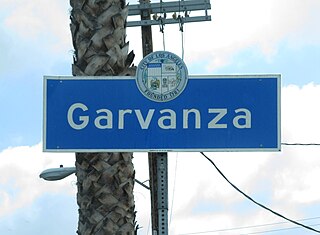
Garvanza is a neighborhood in northeast Los Angeles. Fourteen Los Angeles Historic-Cultural Monuments are located in the neighborhood.
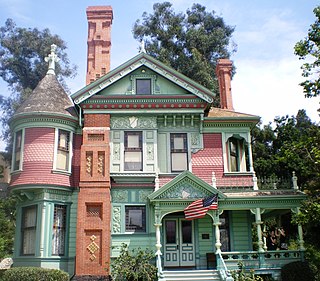
Heritage Square Museum is a living history and open-air architecture museum located beside the Arroyo Seco Parkway in the Montecito Heights neighborhood of Los Angeles, California, in the southern Arroyo Seco area. The living history museum shows the story of development in Southern California through historical architectural examples.
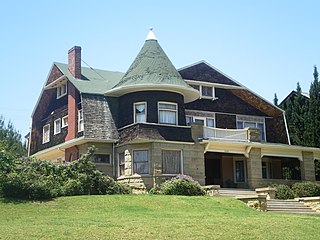
Alvarado Terrace Historic District is a designated historic district in the Pico-Union district of Los Angeles, California. It is located southwest of Downtown Los Angeles, along Alvarado Terrace between Pico Boulevard and Alvarado Street.

Los Angeles Nurses' Club is a clubhouse and apartment building for nurses located in the Westlake district of Central Los Angeles, California.

Granada Shoppes and Studios, also known as the Granada Buildings, is an imaginative, Mediterranean Revival and Spanish Colonial Revival style block-long complex consisting of four courtyard-connected structures, in Central Los Angeles, California. It was built immediately to the southeast of Lafayette Park in the Westlake District, in 1927.
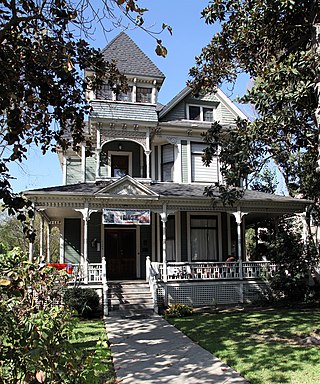
The Miller and Herriott House, also known as the Miller and Herriott Tract House, is a historic Victorian house in the North University Park section of Los Angeles, California. Built in 1890, the house is considered to be a combination of Stick and Eastlake styles. The identity of the architect is not known, though some have attributed the design to Joseph Cather Newsom. A short distance from the University of Southern California campus, the house is now used primarily for student housing.

The Smith Estate, also known as El Mio, is a historic Victorian house perched on a hilltop in the Highland Park section of Los Angeles, California. The street, El Mio, is named after the house, which is how the Smith family referred to it during their residence. Built in 1887, the house was designed in the Queen Anne style by Abram M. Edelman. It has been the residence of a judge who wrote books on occultism, the head of the Los Angeles Railway, and a deputy mayor; and as a shooting location for the cult films Spider Baby, Silent Scream and Insidious: Chapter 2. It has also been declared a Los Angeles Historic-Cultural Monument and listed on the National Register of Historic Places.

The Highland Park Masonic Temple, also known as The Mason Building or The Highlands, is a historic three-story brick building on Figueroa Street in the Highland Park district of northeast Los Angeles, California.

Located in Northeast Los Angeles near the Southwest Museum, the Ziegler Estate is a historic building on Figueroa Street in the Highland Park section of Los Angeles, California. Built in 1904, the building was designed by Charles Hornbeck and Alfred P. Wilson with elements of both Queen Anne and American Craftsman architecture. In the 1950s, Carl Dentzel, then director of the Southwest Museum, purchased it as a potential addition to the Southwest Museum Complex, which also included the Casa de Adobe and the Braun Research Library. The house was recently used as a day-care facility, which closed to allow for renovation.

The North University Park Historic District is a historic district in the North University Park neighborhood of Los Angeles, California. The district is bounded by West Adams Boulevard on the north, Magnolia Avenue on the west, Hoover Street on the east, and 28th Street on the south. The district contains numerous well-preserved Victorian houses dating back as far as 1880. In 2004, the district was added to the National Register of Historic Places.
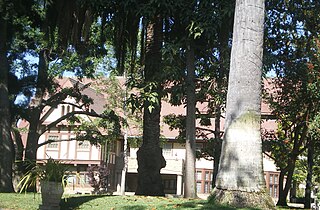
The Ramsay-Durfee Estate, also known as Durfee Mansion, Durfee House or Villa Maria, is a historic Tudor Revival style mansion in the West Adams Terrace neighborhood of Los Angeles. It has been designated a Los Angeles Historic-Cultural Monument and listed on the National Register of Historic Places.

Memory Chapel is a Los Angeles Historic-Cultural Monument located in the Wilmington section of Los Angeles, California, near the Port of Los Angeles. Built in 1870 in the Carpenter Gothic Victorian architecture style, it is the oldest Protestant church in the Harbor area. Originally located at "F" Street and Marine Avenue, it was moved to its present location in 1939. In 1946, the chapel was designated as a historical landmark under auspices of the Wilmington Parlor No. 278, Native Daughters of the Golden West.
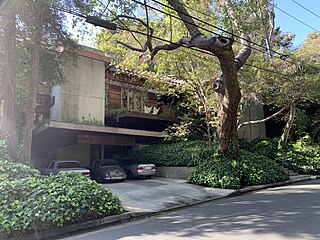
The Kappe Residence is a house in the Pacific Palisades section of Los Angeles, California, designed by architect Raymond Kappe, FAIA, as his own residence. It is a modern design built into a heavily treed hillside. It was designated a Los Angeles Historic-Cultural Monument in 1996, and in 2008 it was named one of the top ten houses in Los Angeles by an expert panel selected by the Los Angeles Times.
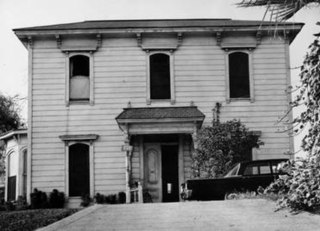
The Salt Box was a house built in the early 1880s in the Bunker Hill section of Los Angeles, California. Designed in the saltbox style that was popularized in New England, it was originally located at 339 South Bunker Hill Avenue. It was the home of physician Dr. A.G. Cook for most of the 1880s. In the late 19th century, Bunker Hill was one of the most prestigious neighborhoods in Los Angeles and was the site of many elegant Victorian homes. The Los Angeles Times wrote of old Bunker Hill: "Nowhere else in Los Angeles was the architecture so ornate. The mansions were wooden-frame Victorian with Gothic gingerbread touches applied with a heavy hand to simulate masonry." Though not as elegant as many of its Victorian neighbors, the Salt Box was "cherished by architecture students for the simplicity of its design."

Palms-Southern Pacific Railroad Depot is a historic railroad depot built between 1886 and 1888 in what is now the Palms section of Los Angeles, California. The two-story wood depot was originally located at the corner of National Boulevard and Vinton Avenue.

In the New World, Queen Anne Revival was a historicist architectural style of the late 19th and early 20th centuries. It was popular in the United States, Canada, Australia, and other countries. In Australia, it is also called Federation architecture.























